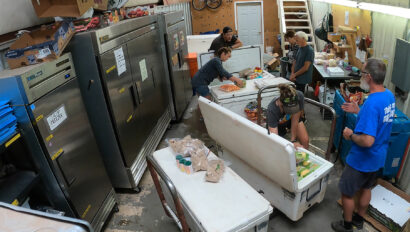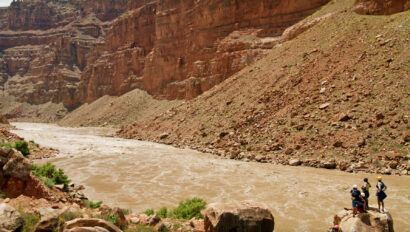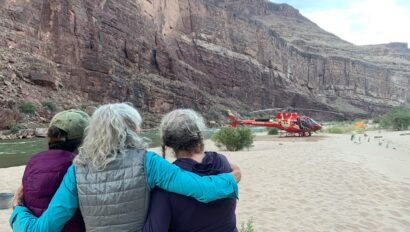They Call Me Groover Boy

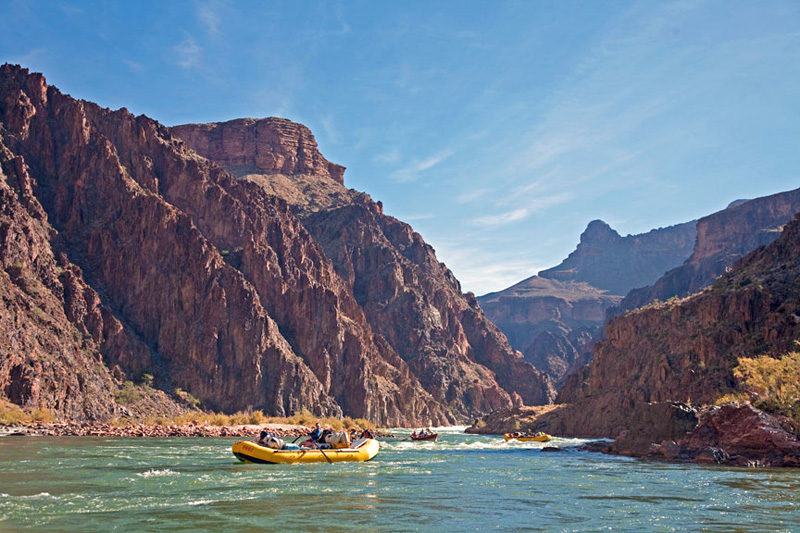
But it isn’t because of my dance moves. My life at the helm of a Colorado River latrine raft.
It’s a fiery June morning at Grapevine Camp, a spit of sand tucked along the banks of the Colorado River, deep inside the stone walls that frame the sub-basement of the Grand Canyon. From the surface of the river, the walls soar upward for more than a vertical mile, exposing geology that extends 17 million centuries into the past. During that span, the oceans have swollen and receded a dozen times, the continents have slammed together and cracked apart again, and a chain of mountains higher than the Rockies has been heaved into the sky and reduced to gravel.
Philosophically speaking, this is some heavy shit. Heavy enough to make a man perched on the bow of a humble raft at the edge of Grapevine—a man now staring at that staggering immensity of stone—scratch his head and wonder what it all might suggest about his own place in the universe.
But that doesn’t last long. Any confusion about where I fit into the cosmos is vaporized by the arrival of a hefty steel box that two of the guides on this 19-day river trip are slinging onto the aluminum deck of my raft with a rude, clattering ka-thunk.
“Heads up, there, my friend,” warns Bill “Bronco” Bruchak, a boatman who’s built like the beer truck he used to drive in Pennsylvania. “Don’t pull a muscle when you lift this thing.”
“Yep,” chimes in Mike “Milty” Davis, a small, cheerful guy with mischievous eyes and a snowy white beard. “That is one enormous box of poop.”
I seize the handles, heft the cargo, and stagger toward the tight space between the stanchions that cradle my 12-foot-long, fiberglass-reinforced oars. Two identical canisters are already anchored on both sides of the footwell, which is where I sit when I row this barge. The top of each can is emblazoned with a strip of red electrical tape labeled FULL!!!
As I start lashing down the new can, I glance over at Monte Tillinghast, who’s piloting the second baggage boat on this trip, a kitchen raft that’s tied up next to mine.
“Son, you do have a load there,” observes Tillinghast, whose cowboy hat and surfer shorts make him look like a maritime version of the Marlboro Man. “You know, you might want to think about girth-hitching another strap onto that there—”
Monte’s suggestion, undoubtedly helpful and possibly of critical importance in how my day is about to unfold, is cut off when Andre Potochnik, the alpha boatman leading this trip, yells out, “Dories … ho!“
This sends Monte and me scrambling to complete our rigging and fall in behind the four dories, which, one by one, are now threading into the main current. As the last of these craft glides past my barge, the final member of our crew—a slim, deeply tanned woman named Billie Prosser—flashes a smile. “Hey, Kevin,” she says sweetly. “Thanks again for doing what you do.”
Her four passengers nod gamely, but their smiles are a frozen mix of polite gratitude and mild repugnance. After nearly a week on the river, these folks know exactly what’s in the boxes on my boat. After all, they put it there. And although they’re deeply obliged for my services, they’re still trying to get a handle on who I am, what my job entails, and why in the world I agree to do it. It’s a look that says, Someone give this poor idiot some career counseling. Immediately.
Four years ago, at age 38, I wandered through the doors of Grand Canyon Dories, an outfitter in Flagstaff, Arizona, that runs commercial expeditions on the Colorado River, and found myself staring at a tiny navy of wood-and-fiberglass rowboats. There were only about a dozen of these sleek, flat-bottomed craft inside the boathouse on that morning in March 2004. They were all painted in bold colors, and several featured flat transoms inscribed with hand-drawn scenes from the river: a bighorn sheep, a cluster of columbines, a tree frog. Each boat was graced with the simplest and loveliest lines I’d ever seen.
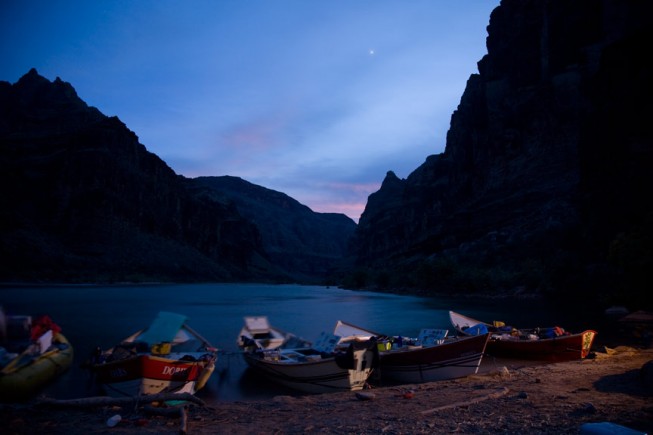
At the time, I had no idea that dory boats, which had been used for centuries by cod fishermen on the gale-racked combers off the Grand Banks of Newfoundland, had become legendary on the Colorado, where they are renowned for their speed and elegance. What I did know was that I was entranced. And in an impulse that defied logic and common sense, I decided—right then—that I was going to quit my job and somehow find a way to follow those boats into the water-haunted world at the bottom of the Grand Canyon.
Plenty of middle-aged men flirt with delusional schemes like this—and almost all of them wind up abandoning their fantasies once they come to their senses. For better and worse, I followed through on mine, even after I found out that becoming a guide involves a multiyear, unpaid apprenticeship in the exciting field of latrine management.
I didn’t care. In fact, over the next four summers, I volunteered for extra poo-boat duty to compensate for my lack of skill in crucial areas like, say, rowing. In the course of 14 trips through the canyon, I have transported more than 7,800 pounds of excrement over a total distance of 3,400 river miles—roughly equivalent to rowing an inflatable septic tank from Tijuana, Mexico, to Point Barrow, Alaska. The price I’ve paid for this dubious distinction has been both humbling and steep. At 43, I find myself with no wife, no kids, no dog, and virtually no bank account. Last year, according to a nationwide survey of incomes across the U.S., I made less money than a part-time doughnut fryer in Maryland and a hospital clown in New York.
For the most part, it’s been worth it—I wouldn’t trade my Grand Canyon experiences for anything. My other consolation is that poo-boating, gross though it may be, is important work. Every summer, about 25,000 people opt to ride motorboats, oar rafts, or dories down all or part of the river corridor through the canyon, a route that stretches 277 miles from the eastern head, at Lees Ferry, to the western terminus, on the shores of Lake Mead. These trips usually take between one and three weeks, and because the average person will produce an ounce of excrement for every 12 pounds of body weight each and every day, the river-running industry generates more than 100,000 pounds of human waste per year. Inside a narrow canyon that receives less than nine inches of annual rainfall and endures summer daytime highs in excess of 110 degrees, it doesn’t take much to imagine how ugly things could get if waste weren’t handled with extreme care.
Up at park HQ, they take this business seriously indeed. The River Permit Office, on the South Rim, distributes a 45-minute video with detailed instructions on how river trips must containerize human waste, cart it out in watertight boxes, and dispose of it at a sewage-treatment plant. No trip is allowed on the river without proper education for crew and passengers and a written commitment to pack it out. It’s a key component—perhaps the key component—of a complex set of rules that keep the crown jewel of the U.S. national park system as pristine as possible.
It’s also something most people don’t like to talk about.
If you sign on for a commercial Grand Canyon river trip, you’ll learn about all sorts of fascinating things, from the Colorado’s maximum depth (85 feet) and minimum width (76 feet) to the number of rock layers exposed along its length (26). The subject you won’t hear discussed is the one I’m most attuned to: poop handling, and the headaches and disasters it can entail. For example, you probably won’t hear about the two guides who were driving back from a river trip when their poo cans fell off the back of their truck and burst open in the middle of the road, creating a fecal slick that a bicycle tourist wiped out on. Or the unlucky boatman who had a leaky toilet transform his rubber raft into a tub of raw sewage. Or the hapless guide who tripped while setting up the lavatory, plunged his arm into the poo box, and compounded his problems by vomiting all over himself.
Mishaps like these—which are the exception, not the rule, on most whitewater trips—underscore an unsettling fact that most commercial passengers never have to confront. To wit: A river runs through your Grand Canyon fantasies, and it’s not clean and sparkling. If I do my job right, you won’t have to dwell on that miserable reality. In a way, I’m like Quasimodo with an oar and a toilet brush. I’m not easy to look at, but things work a whole lot better when I’m around.
A Grand Canyon oar trip usually involves 16 passengers who ride in four boats and are served by a crew of six. If it’s an expedition run by Grand Canyon Dories, each guide rows an elegant 17-foot dory named after a natural wonder that was heedlessly destroyed by man—in the case of the trip we’re currently on, the Ticaboo, the Yampa, the Lava Cliff, and the Vale of Rhonda.
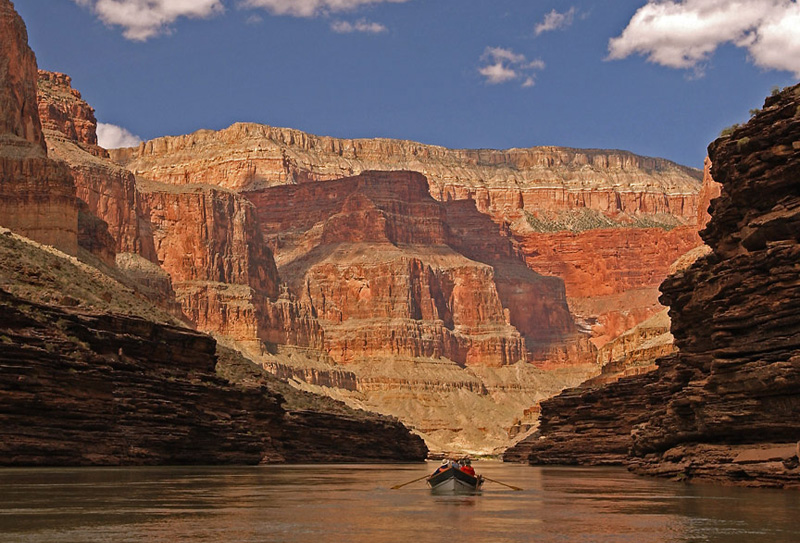
Every trip is also supported by two inflatable rafts that boast absolutely none of the dories’ seductiveness or charm. These baggage boats haul most of the gear, grub, garbage, and goop, and they’re assigned names that are considerably less lyrical. The first raft, the kitchen boat, carries a tangled assortment of tables, coolers, propane tanks, rescue gear, and watertight bags containing the clients’ clothing. It’s usually called the Mule, Ox, or Clydesdale. The other boat, my boat, is called the Jackass.
The toilet setup aboard the Jackass relies on the classic “20-mil” ammunition can, a narrow metal box—14.5 inches high, 18 inches long, and 8 inches wide—originally designed to store antitank grenade rockets for the army’s M1A1 bazooka. Each “rocket box” can handle approximately 50 deposits of human waste and tips the scales at about 45 pounds when full. Its key feature is a rectangular lid that creates a watertight seal to prevent spillage while locking in the odors (well, most of them). When the lid is popped open, an aluminum flange called a riser is placed on top of the box and a toilet seat is mounted on the riser. During an early river trip back in the 1970s, shortly after this system was developed, the toilet seat was accidentally left behind, the rims of the riser left telltale indentations on everyone’s bums, and the box got a nickname: the groover. (Some guides also call it the duker or the unit.)
Every evening when we pull into camp, the passengers clamber out of the dories and form a “fire line” at the bow of the Mule to help Monte unload the kitchen boat. Then everyone gets out of the way while I heave the toilet components onto the front deck of the Jackass and, with help from a guide, lug everything to a private spot, screened by trees or rocks, away from camp. I pull the lid off the box, slap on the seat, and declare the unit open for business.
Groover etiquette follows a strict protocol that the trip leader lays out in a “poo talk” on the expedition’s first night. The most dismaying moment comes when it’s revealed that the rocket box is used exclusively for solid waste, while urine goes into a special five-gallon bucket placed nearby. (If everyone peed in the groover, all my rocket boxes would be full before we got halfway to Lake Mead.)
Many passengers are initially appalled by this. Here they are, each having paid $4,314 for a deluxe river experience, only to discover that their daily constitutional requires a pants-around-the-ankles shuffle between a turd box and a pee bucket shared by 21 other people. But once they get their minds around it, the clients usually come to see the unit in a radically different light. It’s not affection, exactly, but you could call it grateful acceptance.
Professional poo-men help things along with an eye for aesthetics. Over the years, every camp in the canyon has acquired an established groovering spot, and many of these locations are so sublime that they’ve become famous in their own right. At Whitmore Camp (186 miles from Lees Ferry), we like to set up under an overhanging chunk of black lava in a spot bathed in the scent of verbena blossoms. At a place called Ledges (mile 152), you have to climb 30 feet up a stone terrace and balance on a shelf of exquisitely sculpted Muav limestone. And at mile 136, you can sit on the thunder throne while staring into the center of Deer Creek Falls, the longest and loveliest cascade on the river.
Perched on the seat, it’s not unusual for passengers to take notice of things they missed during the day’s excitement: the trill of a canyon wren, the sweetest-sounding bird on the river, or the whorled mysteries of sunbeams playing among the interlocking currents of an eddy. “I’ve had passengers repeatedly tell me that groovering spots are some of the most exquisite places they’ve been,” says Michael Ghiglieri, another guide I work with. “The pooper is often the place for meditation—so much so that people sometimes forget why they’re sitting on the thing in the first place.”
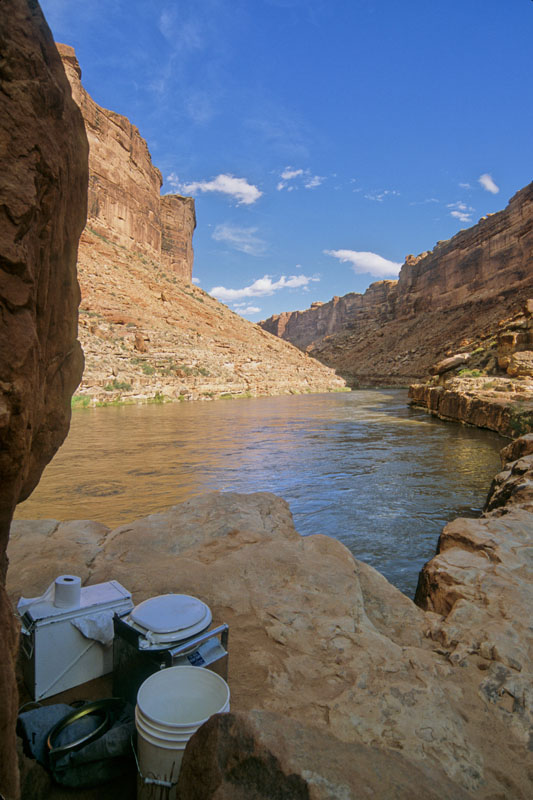
We toilet wranglers take pride in our skills, and I’m pleased to report that our talents have received modest recognition. In 1997, a guide named Joe Lindsay put together a book-length homage to the trials of poo-boating called Up Shit Creek: A Collection of Horrifyingly True Wilderness Toilet Misadventures. In 2002, a part-time poo captain named Scott Phair—a former pig farmer from Maine who now works as a high school principal—produced a calendar called “Groovin’ in Grand Canyon,” which featured photographs of the finest latrine venues on the river. At the time, Phair’s finances permitted him to print only about 20 copies of this landmark publishing sensation. But he’s hoping his next trip through the canyon, this spring, will yield material for a more commercially ambitious redux version, due out sometime in 2009.
Things were not always this organized. Back in the early 1950s, when the business of Grand Canyon river trips was just getting started, the system was simpler, but not necessarily in a good way. “Our motto was ‘Go high and far, and don’t forget to take a match,’ ” recalls 91-year-old Martin Litton, the founder of Grand Canyon Dories. “You’d go off behind a cactus or some rocks to do your business, then you’d pile a few twigs on top and burn it all up. That took care of everything.”
Well, yes and no. “Often, the toilet paper would fail to burn and you’d be left with a real mess,” says one of Litton’s early boatmen, who prefers to remain anonymous. “Other times, you’d light those twigs and, before you realized exactly what was happening, the flames would get out of hand—at which point you’d have to start jumping up and down with your pants around your ankles, stamping out the fire and, of course, tromping all over your own poop. It became quite evident that something had to be done.”
The answer was a compact toilet designed for small sailboats, which was introduced to the canyon in the early 1970s. This “marine potty” featured a detachable tank containing a chemical known as Blue Goo, which is still used in RV parks to aid in fecal decomposition. “Every morning you’d dig a hole on the beach and you’d empty out the tank,” says John Blaustein, a veteran doryman. “It was grim business. The Blue Goo, which smelled like bubble gum, would splash everywhere, so afterwards you’d have to fling yourself in the river for a full-on bath. But then you’d fill the hole back up with sand, and that seemed to solve the issue. At least for a while.”
The problem was volume. As river-running caught on, the number of people floating through the canyon exploded from just 205 in 1960 to 9,935 in 1970. By 1971, 21 companies had licenses to guide passengers, and almost all these outfits were burying their toilet tanks’ contents on the camping beaches, the most popular of which were occupied nightly from May through September.
“With all that usage, the Goo started leaching up to the surface, so when you pulled into camp, you’d see these blue-green stains in the sand, and the first thing you’d be hit with was the smell of feces,” says Brad Dimock, another veteran doryman. “There was also toilet paper all over the place, and the flies were everywhere. It was fucking hideous.”
That’s when Steve Carothers stepped in. A Flagstaff-based biologist, Carothers completed his first canyon trip for the Arizona Academy of Sciences in the spring of 1971. He was so horrified by what he saw that he set out to devise a better way. He quickly realized that a WWII rocket box, which could be purchased at any army surplus store for $10 to $15, offered an ideal container system. The trick was figuring out how to control the methane, a by-product of anaerobic decomposition, to prevent overheated boxes from detonating. (After cooking in direct sunlight, the expanding miasma of methane is capable of blowing the lid off the groover and enveloping an unsuspecting boatman in a blast of superheated crap. It’s happened before; boatmen tremblingly refer to this phenomenon as a “pooplosion.”)
Carothers performed rudimentary tests involving glass jars, pipettes, and methane-generating contributions from his office co-workers. (Don’t ask.) He discovered that an ounce of formaldehyde was “extremely effective at retarding the gas production.” In the fall of 1976, he published an article in Downriver Magazine called “It’s Time for Change, Let’s Haul It All Out!” which featured detailed instructions on the rocket-box system. In 1978, the Park Service made his technique mandatory—and, with only minor modifications, the system is still used today.
“What a tremendous difference it’s made,” says Carothers. “This is probably the most significant contribution I’ve made to science and wilderness in the last 31 years.”
Carothers also discerns a philosophical dimension to his work. “In America, most of us are taught not to think much about our feces, and we’re certainly taught not to talk about them,” he says. “But as human beings, we all produce about a pound of poo a day, and dealing with our shit responsibly is one way for us to face our humanity. Intellectually, that’s very satisfying to me. I suppose it’s kind of a metaphor for life. Don’t you agree?”
That’s hard to dispute. My only teensy gripe with Carothers’s system is that it funnels most of the degrading labor onto one guy: me.
A poo captain’s day is long and hard, and it usually begins at first light, when he gets up with the rest of the crew. On this particular expedition, the routine is pretty standard: While Andre, Billie, Milty, Bronco, and Monte fix breakfast and clean the dishes, I focus on my duties as the trip’s turd-transport specialist.
I start by rounding up my 16 pee pails—small plastic paint cans, purchased at Home Depot, which I place in front of the passengers’ tents every night so they won’t have to stumble off to the groover after dark. Then I stuff whatever garbage I can scrounge into a trash bag and drench it with liquid bleach to prevent the Jackass from turning into a floating fly farm. Today marks the end of our first week on the river, so I also perform a quick inventory to confirm that we have an adequate supply of toilet paper (one roll per person for every five days), Clorox crystals, hand soap, air freshener, and, most important, empty rocket boxes. (I carry a total of 11 to see us through a 19-day trip, with a one-groover safety margin.) Finally, I check the day-tripper—two smaller ammo cans containing a roll of TP, a jar of hand soap, and about four pounds of Feline Pine kitty litter. This system is for clients who cannot avoid using the toilet during the day.
Around 7:30, as the crew starts dismantling the kitchen, it’s time for me to encourage everyone to finish groovering. This is demeaning, but it’s also a bit of a power trip. When I yell “Last call on the groover!” what I’m really telling people is “No matter how important you are, I’m about to revoke your bathroom privileges for the next eight hours.” It doesn’t matter that Steve sits on the board of the New York Stock Exchange or that Maureen is a highly placed official at the Commerce Department. It also doesn’t matter that Ben pounds nails in Portland or that Emily, who runs a crane at the docks in Port Arthur, Texas, has been saving pennies for most of her adult life to afford this trip. In the eyes of the groover, everyone is created equal.
Everyone except me, of course. When the passengers are finished, I’m the guy who gets to grab a guide, dash up through the tamarisk trees, and break down the system.
If the groover is getting full, I lift it and drop it on the sand a time or two to “settle” things—being extremely careful not to compress the contents too tightly. (After baking in the sun for another two weeks, the contents of a compressed rocket box can cement to form what we call poo glue, which will be almost impossible to remove at the Wildcat Hill Wastewater Treatment Plant, in Flagstaff.) Then I shower the inside with a furious deluge of Clorox crystals, which helps beat back the odor. We cart the toilet seat down to the river with the riser and urine bucket, where the urine is dumped in the water and all components get a thorough scrubbing. Finally, we seal the lid and begin the Morning Poo Parade.
This can be embarrassing. As we haul our load toward the beach, the passengers spot us coming and conversation often grinds to a halt. Someone might break the silence with a remark such as “Stand back, here comes Groover Boy!” Other times, there is a subdued chuckle punctuated with a joke like “Hey, did you know that Grand Canyon poop boatmen never die—they just smell that way?”
Ha-ha, I laugh, that’s really funny. Then I pretend to stumble, which sends everyone running down the beach screaming.
As the guides hoist the components onto my front deck, I leap aboard and start tying everything down, often rigging double and triple backups to ensure that nothing goes flying out. It’s a complex operation—I use nearly 40 cam straps to properly anchor the pee bucket, the 16 pee pails, the riser, the three bags of toilet paper, the garbage, the groover seat, and the rocket boxes, plus all my Clorox and cleaning supplies.
When the lashing is done, I’m surrounded by a mountain of trash and toilet products. You’re probably familiar with those wheeled carts used by folks who clean the bathrooms at airports and hospitals? Well, that’s what the Jackass looks like, with one big difference. When I’m finished rigging, I have to row the goddamn thing through some of the biggest commercial whitewater in North America.
As the Colorado River muscles down the canyon, it stair-steps through more than 160 rapids, the largest of which can casually flip a 37-foot motor raft or smash a dory to pieces. Take Horn Creek, which is on our dance card this afternoon. It features a pair of exposed guard rocks upstream of a double hole backed by two hydraulic jumps that are sometimes called the Great Wave and the Green Guillotine.
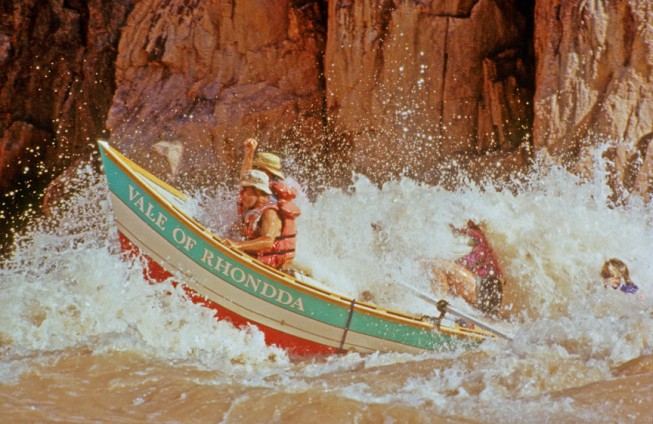
The key to unlocking Horn Creek lies just below the right guard rock, where the current forms a shallow wave, known as a “lateral,” that radiates downriver in an expanding triangle. A textbook entry starts on the far right side of the river and involves rowing—sideways and backwards—to a point just below the right guard rock. The trick is to build enough momentum so that you punch neatly through the lateral and into the calmer water inside the triangle. It’s a straightforward move, but a heavily laden poop boat tends to complicate things. Imagine trying to row an outhouse, in reverse, down a wall of whitewater, and you’ve got some idea of what it feels like to take the Jackass through Horn Creek.
I watch as all four dories and Monte’s Mule thread the entrance flawlessly. As several passengers raise their arms and yell “Whoo-hoo!” each boat skates across the tongue, harpoons through the lateral, and bobs merrily into the tail waves. Then it’s my turn.
Among apprentice boatmen, mistakes are inevitable, and as I plow across the tongue I commit a humdinger. Instead of spearing cleanly through the lateral, I rebound off it and ricochet directly into the vortex. The top of the Great Wave surges over the front of the Jackass, hitting me in the face and chest with enough force to knock the lenses out of my glasses, drive me out of my sandals, and hurl me over the side of the boat, straight into the Green Guillotine.
Oh, hell.
The ordeal of being tossed into the center of a Class V rapid is referred to as “getting Maytagged.” The wash cycle starts with a sharp crack to the side of my head—the blade of my right oar—as the current sucks me toward the bottom of the river.
In situations like this, veteran boatmen will tell you it’s essential to remain calm. I’m in no mood to comply with this formula, however, because even though I can’t see a damn thing underwater, I’m pretty sure I know exactly what’s happening to the Jackass up on the surface. In my mind’s eye, it goes like this:
As the Great Wave flips the half-ton raft upside down, the boat drifts helplessly into the maw of the Green Guillotine, which starts clawing her to pieces like a pack of ravenous hyenas disemboweling the carcass of a wildebeest. As the lashings on the aluminum frame and the nose cones give way, my toilet supplies explode in all directions. But that pales in comparison with what I’m sure is being done to my poo cans. Unable to withstand the hammering, the lids are popping off, the rocket boxes are sinking like stones, and the collective contents of all five groovers are spewing out in a giant, thundering geyser: a toxic, 250-pound plume of raw waste that will turn this stretch of the Colorado into a Superfund site. It’s an appalling debacle, and surely it will spell the end of my dream of becoming a river guide …
Given what I’m picturing, it’s actually a bit of a disappointment when Horn Creek’s hydraulics, instead of drowning my sorry ass, shoot me toward the surface, where I’m squirted through the tail waves looking like a wet cat. I’m so horrified by what’s happened that my best option seems to be to dive back underwater and stay there. But suddenly I see the transom of the Vale of Rhonda, with Miss Billie Prosser at the oars, ordering me to grab her gunwale.
“Oh, my God, Billie, the Jackass!” I sputter as I latch on to the side of her dory and get dragged through the water.
“No worries,” she says. “The Jackass had a great run. Much better than you did.”
And, sure enough, there she is. Despite my incompetence, my humble yellow dung barge has performed a series of deft solo moves—threading Horn Creek’s maelstrom on nothing more than the shining fortitude of her own righteousness—and now she’s bobbing in an eddy on the far side of the river. Beautifully upright, perfectly intact, she offers an important nuance to Steve Carothers’s Philosophy of Poop:
Despite your best efforts, it is not always possible to deal with your shit responsibly. But every now and then? Your shit will just take care of itself.
It’s now nine o’clock in the evening. The toilet is up; the pee pails are distributed. Down at the edge of the river, where the dories and the rafts are securely tied to each other, the crew enacts an abridged version of the bedtime ritual on The Waltons—
“G’nite, Monte …”
“G’nite, Kevin …”
I unfurl my air mattress and crawl into my sleeping bag, and you’re probably wondering: So what goes through the mind of a 43-year-old man who’s about to spend the night sleeping on top of six poo cans?
Well, I should probably be planning how to rearrange those groovers in the morning, so that the Jackass will be balanced evenly for the enormous rapids downriver. But instead I’m dwelling on how badly I screwed up my run. Not just this afternoon’s bungled trip through Horn Creek, mind you, but the longer, more misguided run down the river that is my life.
During my trial-by-fire odyssey as a poo-man, I’ve often wrestled with the question of why I chose to do this and whether it has been an enormous mistake. Whenever I take stock of all the regrets and missed opportunities I haul around like the rocket boxes on my raft—the career I’ve squandered, the women I’ve let down—I can’t help but conclude that I’ve conducted myself like a jackass. By any accurate definition, my current state of affairs looks and sounds like failure. But on a night like this, as I lie on my boat floating in an eddy at the bottom of the canyon, with Jupiter’s lantern swinging in the sky, it doesn’t quite feel like failure.
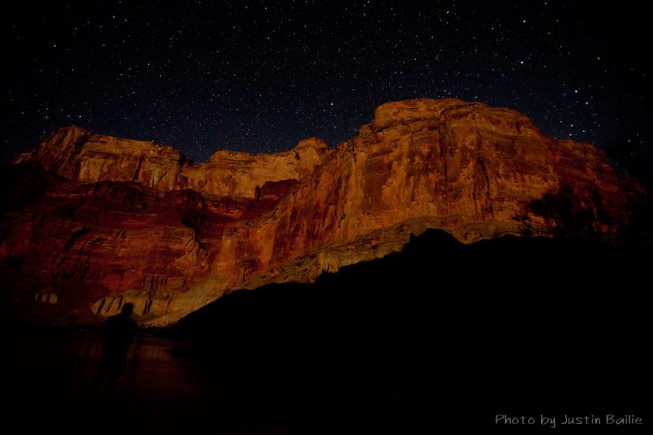
Granted, I have spent some truly miserable moments on the river. But those ordeals have also been leavened by moments of simple, unvarnished perfection. I have seen summer thunderstorms send dozens of waterfalls simultaneously plummeting from the rimrock to the river. I’ve rowed past bighorn rams battling each other on the cliffs, the sound of their head-knocks echoing off the stone. I’ve napped on beds of columbine and hellebore orchids, and gazed at the turquoise waters bubbling from the subterranean pool that the Hopi believe to be the wellspring of life.
Those are wondrous things, to be sure. But the real reason I don’t feel like a complete loser has less to do with the gifts that I’ve been given and more to do with what’s been taken away. By stripping most of my pride, my apprenticeship has laid bare one of the more intriguing paradoxes of the Grand Canyon: the fact that this place has the power to render a person not only profoundly diminished but also radically expanded, often in the same breath. Of the many things that the canyon and the river supposedly offer, this may be the purest of them all.
So, yes, it’s true: If I keep at this baggage-boat gig for a few more years, I may someday enjoy the privilege of rowing actual passengers down the Grand Canyon. In the meantime, the Jackass needs a captain—a role that commands, in my experience, an unexpected dimension of dignity and even a measure of grace. It’s a job whose principal dividend, I suppose, is a subdued and somewhat battered frame of mind that, as the moon prepares to rise over the rim and the night cups the river in its hands, feels almost like happiness.
This story, written by Emerald Mile author, Kevin Fedarko, originally appeared in Outside Magazine in July 2008 and has been reprinted here with permission.
Related Posts
Sign up for Our Newsletter

